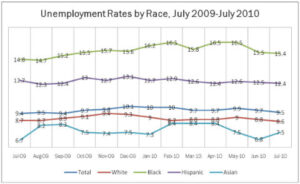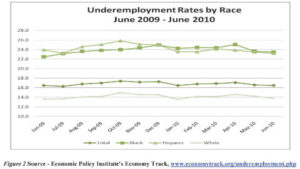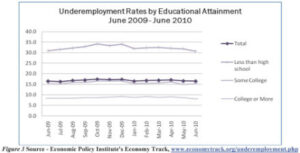Expanding Opportunity for All: Economic Justice
This memo provides guidance for discussing greater and more equitable job creation with policymakers, media, and persuadable members of the public. While public and political demand for job creation is high, public attitudes toward the role of government, the success of the Recovery Act, and the need for deficit reduction increasingly stand in the way of effective action on this front. And the importance of ensuring quality jobs that reach all of America’s diverse communities is often lost in the debate. This memo includes background information on the economy and employment, current public opinion research, and messaging advice about starting constructive discussions on job creation.
Putting America Back to Work
Creating good jobs that help American workers take care of their families is an urgent national priority and central to preserving the American Dream for all. We can’t just wait for jobs to happen; we need public investment in expanded job opportunities for everyone. Jobs need to be available at all levels of the economy, and in all sectors, and we all have a stake in making that happen. We’ve seen what happens when we ignore the fact that we’re all tied together in this economy. It’s time to implement policies that work for everyone.
The Impact of the Stimulus: Economic Assessments and Public Attitudes
Despite public questions about the efficacy of the stimulus, prominent economists have noted that, absent intervention, the economy would have worsened significantly.1 In fact, according to some estimates, without the stimulus, “GDP in 2010 would be about 11.5% lower, payroll employment would be less by some 8½ million jobs, and the nation would now be experiencing deflation.” 2
Such assessments are complicated by conflicting public opinions about government’s role in rescuing the economy. For example, Americans want the government to act, but lack faith in its ability. A post- stimulus survey3 found that more than 60 percent of respondents felt that the government needed to “take a larger and stronger role” in resolving the economic crisis. At the same time, “most individuals believe they personally got themselves through the recession rather than lawmakers”1 and are skeptical that the stimulus plan passed last year has really made much difference in putting us on the road to recovery (42 percent say it will not help improve the economy and 44 percent see no impact).4 This attitude may be fueled in part by fears about the impact of the stimulus on the deficit. When asked about the biggest issues that may face the country 25 years from now5, 14 percent indicated that the deficit will be the greatest concern, whereas 11 percent believe that it will be the economy in general. Americans believe that the current economic situation is dire and must be dealt with, but are also worried about the future effects of present-day intervention.
Mid-2010: The U.S. Economy and Employment Outlook
Despite minimal improvement in the unemployment rate (see Figure 1) due to the impact of the February 2009 stimulus package and other recovery efforts, not everyone is experiencing a positive trend. In fact, many groups who experienced unequal opportunity before the downturn face even more daunting challenges now. As Figure 1 shows, unemployment among African Americans and Latinos has remained 30 to 65 percent higher. Furthermore, month-by-month improvements in the total unemployment rate were not reflected by parallel gains in African-American employment.

Figure 1 Source – Economic Policy Institute’s Economy Track, www.economytrack.org/unemployment.php
Underemployment rates, which track unemployed workers actively seeking work, involuntary part-time workers, and marginally attached workers, further highlight the depth and impact of the recent downturn. For example, while the underemployment rate for whites is lower than that of the total population, the African American and Latino/Latina rates – within a few points of each other, as seen in Figure 2 – are well above the rate for the total population.

Even more startling is the difference in underemployment rates across educational levels. While the underemployment rate for those with some college closely mirrors that of the total population, a college or advanced degree ensures a notably lower underemployment rate. And those who have less than a high school degree have an underemployment rate that is double the rate of the total population (see Figure 3).

There were five unemployed workers for every current job opening6 at the end of June 2010. Further, due to population growth, even a “replacement rate” of jobs created would fail to ensure that the economy is “made whole.”7 Although, as of January 2010, 8.4 million jobs had been lost during the current recession, 11.1 million jobs would need to be created to return the country to a pre-recession unemployment rate.
While the gender pay gap hit a historic low of 82.8% in the second quarter of 2010, this is primarily due to the dramatic drop in male wages8. Unfortunately, this leveling in male-female pay disparities is headed in the wrong direction, representing lost income, when we need to improve and balance pay for everyone.
When discussing these economic realities, it is important to lay out for audiences why we should all care about them, and why, to restore the health of our economy, jobs and opportunity must reach all Americans.
Policies that focus only generally on job creation are likely to allow existing disparities to persist and, if not addressed, potentially worsen. An economic recovery that leaves whole groups behind like this is not sustainable and violates the core American values of opportunity and mobility for all. American principles of interconnectedness have real-world consequences for us all – a recovery that doesn’t include middle-class families lacks long-term stability. Furthermore, disparate rates of recovery hide serious problems for many.
Messaging Guidance
- Lead with values. Primary: Opportunity, Community/Common Good, Security. Secondary: Mobility, Redemption/Renewal, Voice, Accountability (use with care)
- Organize messages around a core narrative focused on The American Dream, Solutions, and the National Interest.
- Focus on jobs: Investment in quality jobs over immediate deficit reduction.
- Acknowledge progress on equal opportunity, while over-documenting barriers.
- Emphasize Government as a connector, planner, able to pave the way for progress.
- Tell thematic stories, connecting human stories to systemic problems and solutions.
- Frame the opposition’s approaches as divisive, impractical, and out of touch.
More Tips:
- Lead with values, such as the shared value of opportunity for all.
Those who want to work should have a chance to provide basic security and stability for themselves and their family. Good jobs are the foundation for realizing the American Dream for all. - Organize messages around a core narrative on economic recovery, including the themes: The American Dream, Workable Solutions, and National Interest.
The American Dream
This country stands for opportunity. We need to focus on expanding opportunity, not restricting it or allowing historic barriers to continue to foster inequality among us. The ability to care for one’s family, to move forward, and to thrive is at the core of the American Dream, and all of that depends on quality jobs. The American Dream must be available to everyone. Only a transformational, equitable recovery will ensure this treasured ideal continues to exist for all of us.
Workable Solutions
We have emerged from crises before by relying on American ingenuity and know-how, so it is within our power as a people not only to bring our economy back from this recession, but also to tackle the inequalities that burdened many communities before the downturn began. We need to move forward, with government paving the way, on a commonsense, practical agenda that expands opportunity for everyone here.
National Interest
The causes and effects of this economic crisis have illustrated how we are truly all in this together. When we allow inequality to fester and harm whole communities within our national fabric, it weakens us all. Recovery needs to be about mending and strengthening the entire cloth, so that we are prepared to face the future together.
- Focus on jobs: Investment in quality jobs over immediate deficit reduction.Economists agree that we must end the jobs crisis and the recession first. The best deficit reduction method is putting Americans back to work.
- Acknowledge progress on equal opportunity, while over-documenting barriers.Although the earnings gap between men and women has recently narrowed, it continues to affect us all. The current recession has resulted in more lost jobs for men, increasing the reliance of many families on women’s earnings. Currently, more than 12 million families with children rely primarily on women’s earnings.9 By eliminating the gender wage gap, those families would have access to 17- 23% more income, increasing the spending power and economic stability of these families, which is good for all of us.
- Emphasize Government as a connector, planner, able to pave the way for progress.Our nation’s greatest leaps forward have always come when we have invested in an effective partnership between government and our people. Think of child immunization programs that have wiped out devastating diseases in our country; our Social Security system that has enabled millions of seniors to move out of poverty, and Medicare, which has kept them safer and healthier regardless of their wealth, race, or ethnicity; even the interstate highway system, which connected us as a single prosperous nation. In order to effectively address this economic crisis, we need that kind of investment today.
- Tell thematic stories, connecting human stories to systemic problems and solutions.Those who want to work should be able to work. We’re all familiar with news stories showing people lined up around the block waiting to enter a job fair. This is only one example of the many people seeking opportunity, but encountering multiple barriers to it.
- Frame the opposition’s approaches as divisive, impractical, and out of touch.The suggestion that an unregulated market economy offers the best hope for creating opportunity ignores current economic realities. The worst economic downturn in decades was only reversed by unprecedented responses by monetary and fiscal policymakers.
Applying the Message
In order to deliver a consistent, well-framed message in a variety of settings, we recommend structuring opening messages in terms of Value, Problem, Solution, Action. Leading with this structure can make it easier to transition into more complex or difficult messages.
Value:
To preserve the American Dream for all, we need to ensure that everyone who wants and needs to work can do so.
Problem:
Unemployment rates have hovered near 10% for the past year, going as high as 16.5% for African Americans and 13.1% for Latinos/Latinas. However, public fears about the efficacy and cost of job creation have blocked investment in efficient, comprehensive, and equitable job programs.
Solution:
We must support public investment in job creation to prevent long-term damage from the downturn and reduce the future deficit by putting Americans back to work now.
Action:
Tell your representatives in Congress to support the restoration of the American Dream for all by voting for the Local Jobs for America Act.
Notes:
1. Lynch, D.J., Economists agree: Stimulus created nearly 3 million jobs, August 30, 2010.
2. Blinder, A.S., Zandi, M., How the Great Recession Was Brought to an End, July 27, 2010.
3. Gerstein/Agne at Demos/Topos Report.
4. Greenberg, S.B., Economic Mobility and the American Dream Survey, 2009, Greenberg Quinlan Rosner Research & Public Opinion Strategies.
5. Jones, J. M., Americans Say Jobs Top Problem Now, Deficit in Future, 2010, Gallup, Inc.
6. Job Openings and Labor Turnover Summary, August 11, 2010.
7. Turner, A. Jobs Crisis Fact Sheet, 2010, Economic Policy Institute.
8. Goudreau, J., Gender Wage Gap Shrinks To Record Low, September 14, 2010.
9. Boushey, H.; Arons, J.; Smith, L. Families Can’t Afford the Gender Wage Gap, 2010, Center for American Progress.


